A few years ago I posted about an idea that had really caught my attention. It came from a book by Malcolm Gladwell and it looked at 2 types of painters: those who just seem to know what to do, ie they ‘get it’ right away and those who need to work things out. His example of the first type was Pablo Picasso who just burst onto the scene almost fully formed. He knew exactly what he wanted to do and achieved a lot of success right off the bat. The example of the second type was Paul Cezanne who struggled for years and years, practicing, failing, floundering but always learning and striving. He didn’t achieve success until much later in his life.
The reason this analysis was so important to me is that it made me realize that I am an experimenter. I have to work things over and over until I figure them out. It’s almost like I can’t visualize things until I see them on paper. Then I notice that this part of the painting works and this other part doesn’t so I do it again making adjustments and then I notice new things. However, if I do the work and keep at it eventually I do figure things out.
These images illustrate the case completely.
This is my original photo of a street corner in Charing Cross, London. I liked the composition so I did a large 18 x 24 version. There was no sun on the day I took the photo but I wanted a scene that had part of the buildings in sunlight.
I quite liked it but the foreground was always confusing to me. I also wasn’t happy with the effect of the sunlight so I did another 18 x 24 version.
In this version I liked the cleanness of the sunlit parts of the building I also liked the suggested windows and doors at the bottom of the shadow part in the centre. Unfortunately, I still found the foreground area not quite right. In particular I began to see the car as a mistake. Therefore I decided to suspend work on this painting.
Due to some positive response to this painting from my watercolour class I decided to use this image as the next demo for the class. I knew I would have to simplify it in order to teach it so I played with the buildings quite a bit. This next version was done 9 x 12 and the pressure was off. I just did a quick sketch and the process of painting was much more playful.
I liked a lot about this version but found the tree on the left confusing (even though I like the technique I used). I also noticed that the dark building on the right is too large. It serves a useful purpose to lead the eye into the painting but it just takes up too much room. I definitely prefer this version of the car. I then tried it again to incorporate these changes.
I liked this version better without the tree, the smaller dark building and a very loose interpretation of the left edge of the painting which again leads the eye toward the centre. So, inspired by this version, I just set up my camera and made a video for class of me painting it again.
This one I am quite happy with and I feel it is definitely a stronger composition and a stronger painting. For me, however, it would never have happened without all those preparatory steps and the insights gained through them. Unfortunately, I still see things I would like to improve such as the contrast between the roof and the tower at the top centre. Fortunately, I am working on a new 18 X 24 version so I have another chance to make changes.
In summary this process is a lot of work and sometimes I wish I didn’t need to do it this way but I do. I’m just thankful that I have the desire to keep striving and growing because I’ve learned that when you do it always works out.


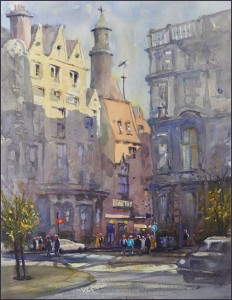
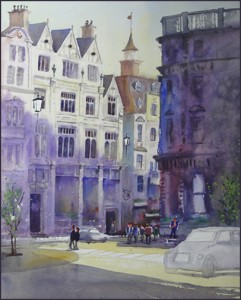
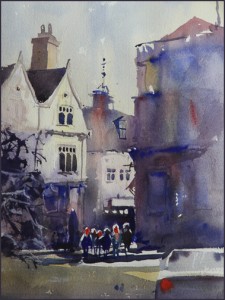
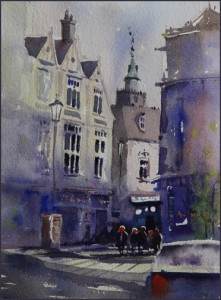
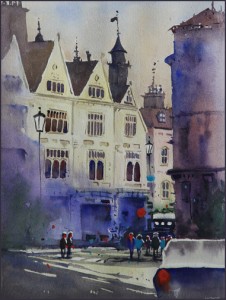
Wow, Rex – so interesing!! I think this was my favorite post – I really like how you explained your process, and I think the last painting is indeed my favorite. It’s fascinating to see the editing in it. I do a lot more writing than I do painting, but it was a good reminder of how making a work more concise/focused can often make it stronger.
I also recall looking at the early drawings/paintings of Van Gogh and seeing how much he developed over time – another good example of someone who did not “spring fully formed” as a master artist. I think one of your favorite books, Drawing on the Right Side of the Brain has the two images below. The one on the left is an early drawing of his; the one on the right is one from two years (and countless hours of experimentation) later…
http://3.bp.blogspot.com/-jchaGmmoUlU/Tbd76iP1GlI/AAAAAAAACAQ/Xz8Tt1_BIRU/s640/453-van_gogh.jpg
Hi Shelley: I’m really glad that you read this. It has been a very insightful process for me. Drawing On The Right Side Of The Brain is the book I’ve based all my drawing classes on. I love it. I also noticed those drawings. I was always amazed at the first one to see the master Van Gogh making basic mistakes. Then with all the work he had to and did put in he reached new heights. I find great hope in this because it says we all can succeed if we are true to our own way of developing. As I’ve heard many times ‘Everything works out in the end and if it hasn’t worked out yet, it isn’t the end’. Take care, Rex
Hi Rex,
Great post, and very helpful insight and visual experimentation. I also find it very very difficult to express my own interpretation onto canvas or paper, and afraid I’m destined to be a continual experimentor rather than a conceptual artist. Having you write about this certainly gives great meaning and insight into the process as well as the differences between different types of artists and their approaches.
I’m wondering if you did a thumbnail value sketch before executing the paintings? would this have helped you reach your goal much faster? I’m finding my own lack of planning like that causes frustrating outcomes, which results in redoing over and over.
I’m currently trying to figure out how to adequately represent different types of water scenes in watercolor, and am working on tweaking each version as you did with your lovely street scene…by the way, I like both the first and second versions of your experiment!
anyway, I’m going to post some of my experimentation later today, and would love your commentary, critique, and advice.
thank you again for a great post and demo!!! – artcat
Hi Adele, thanks for the comment. I almost always do a thumbnail sketch to check composition. I also usually do a value study as well and sometimes a colour study. If these all work out then there is a good chance that the painting will work. For me I have to do these steps if I want to produce the highest quality work. Take care,
Rex
I am enjoying this thread very much. I am an insistent “practicer” – always trying a new technique, new color combinations, new compositions…sometimes with good results, sometimes not. I want to always make the painting my own…and although it has not been busy, I am enjoying very much the journey.
I found all the studies interesting…I liked the first one, most especially for your color choices…my only critique would be that the buildings were not “real-to-life” as compared to the photograph (which because of the easily recognizable buildings would have made that a problem).
I very much liked the latter ones, where you used the buildings to “write your own story” – nothing was supposed to be a realistic, it was painted for the story! (My goal, eventually, as well!)
Kiwi
Thanks for your comment Kiwi. I think there are quite a few of us. Good luck. Rex